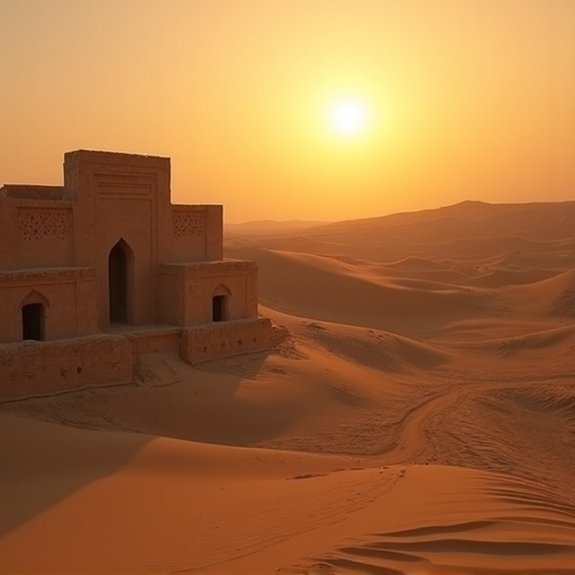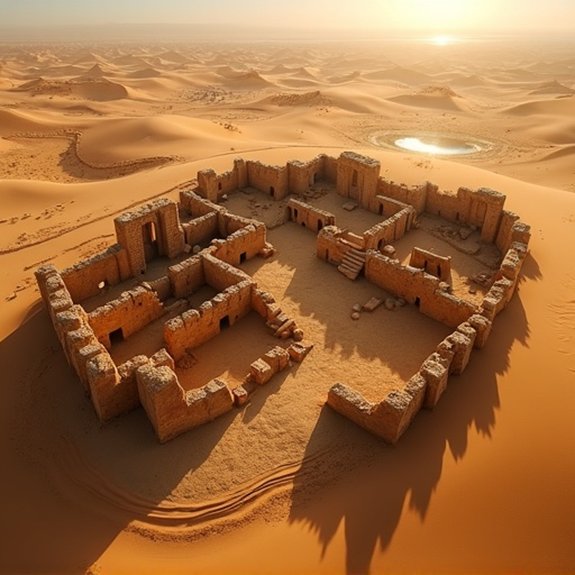The Atlantis of the Sands: Ubar
The legendary city of Ubar vanished into the Arabian desert over fifteen hundred years ago, taking its secrets with it. Archaeologists didn’t find the lost trading hub until 1992, when satellite technology revealed what centuries of expeditions couldn’t locate. The site’s massive fortifications and trade artifacts confirmed ancient accounts of immense wealth and power. But something catastrophic struck this thriving metropolis, and the evidence points to more than natural disaster.
Introduction

What drives explorers to chase legends through endless deserts, risking everything for cities that might exist only in ancient tales? The lost city of Ubar has captivated archaeologists and adventurers for centuries. Known as the “Atlantis of the Sands,” this legendary Arabian trading hub supposedly vanished beneath the desert sometime between 300 and 500 CE.
Ancient texts describe Ubar as a wealthy fortress city that controlled the lucrative frankincense trade routes through southern Arabia. The Quran mentions it as Iram of the Pillars, destroyed by divine wrath for its people’s arrogance. T.E. Lawrence called it “the Atlantis of the Sands,” sparking modern fascination. For generations, explorers searched Oman’s Empty Quarter, finding nothing but scorching sand until satellite technology changed everything in 1992.
Ancient Trade Hub Discovered
The breakthrough came when NASA’s remote sensing technology revealed ancient caravan tracks converging on a single point in Oman’s Dhofar province. In 1992, archaeologist Nicholas Clapp’s team excavated the site near Shisr, uncovering a massive fortress with eight towers and 30-foot walls. They’d found Ubar, the legendary city that controlled the frankincense trade for over 3,000 years.
The discovery confirmed what ancient texts had long claimed. Ubar wasn’t just a myth—it was a sophisticated trading center that dominated commerce between Arabia and the Mediterranean. Artifacts showed the city’s merchants dealt in precious resins worth more than gold. The excavation revealed warehouses, living quarters, and a complex water system that sustained thousands of residents. Pottery shards and coins from Rome, Greece, and Persia proved Ubar’s extensive international connections.
Notable Cases or Sightings

Several ancient writers documented encounters with Ubar before it vanished from history. The Greek geographer Ptolemy marked it on his second-century map as “Omanum Emporium,” placing it in Arabia’s interior. Islamic historian Al-Hamdani described Ubar’s massive fortress gates and towering walls in the tenth century, though he’d never visited personally.
Medieval Arab chroniclers called it “Iram of the Pillars,” connecting it to Quranic verses about a city destroyed for its people’s arrogance. They reported travelers’ tales of ruins glimpsed during sandstorms. Bedouin guides in the 1800s claimed they’d seen broken columns and pottery shards near ancient caravan routes, but couldn’t relocate the sites. British explorer Bertram Thomas recorded local stories in 1930 about a “road to Ubar” visible from specific dunes.
Common Theories or Explanations
While ancient accounts placed Ubar in various locations across southern Arabia, modern researchers have developed competing theories about its fate and exact position. Some archaeologists argue the city collapsed when underground limestone caverns gave way beneath its foundations, creating the massive sinkhole visible at Shisr today. Others suggest drought and shifting trade routes gradually emptied the settlement before natural disasters struck.
Climate data supports theories that desertification destroyed Ubar’s economy. As monsoon patterns changed around 300 CE, the frankincense trees couldn’t survive, eliminating the city’s primary export. Alternative explanations propose that Ubar wasn’t a single city but a territory containing multiple oasis settlements. NASA’s findings indicate the site served as a vital water stop rather than the grand metropolis of legend.
Frequently Asked Questions
How Can Tourists Visit the Ubar Archaeological Site Today?
Tourists can’t easily visit Ubar’s archaeological site in Oman’s Empty Quarter desert. They’ll need special permits, guides, and four-wheel drive vehicles to reach the remote location near Shisr, where excavated ruins remain partially visible.
What Preservation Efforts Are Protecting the Ruins From Erosion?
Archaeological teams’ve installed protective shelters over excavated areas, while conservators apply stabilizing treatments to fragile structures. They’re using drainage systems to prevent water damage and regularly monitoring the site’s condition through digital documentation technology.
Are There Ongoing Excavations Planned for the Site?
Archaeological teams haven’t announced major excavation plans for Ubar currently. Researchers focus on preserving existing exposed structures while conducting limited surveys. Future digs depend on funding, permits, and ensuring the site’s stability isn’t compromised further.
Which Museums Display Artifacts Recovered From Ubar?
Several museums display Ubar artifacts, including Oman’s National Museum in Muscat and the Land of Frankincense Museum in Salalah. These institutions showcase pottery fragments, incense burners, and other archaeological finds that researchers’ve recovered from the site.
What Modern Technology Helped Locate the Lost City?
NASA’s satellite imagery and ground-penetrating radar helped archaeologists locate Ubar in the early 1990s. The technology revealed ancient caravan routes converging at a single point in Oman’s desert, where they’d eventually discover the buried city.
Related Posts

The Forgotten Tomb Beneath the Louvre

Lost Languages Still Untranslatable
